|
|
|
Sort Order |
|
|
|
Items / Page
|
|
|
|
|
|
|
| Srl | Item |
| 1 |
ID:
163203
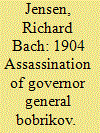

|
|
|
|
|
| Summary/Abstract |
The little-known assassination in 1904 of governor general Bobrikov, the Russian ruler of Finland, by the Finnish Senate clerk Eugen Schauman can be explained as an act of tyrannicide, anarchism, or terrorism. The article analyzes the question of which category this deed fits into and discusses the local and international background of one of the most significant acts of violence in Nordic history. It also postulates that around the time of Bobrikov’s murder in 1904 a fundamental shift occurred in the usage of the term “terrorism,” which began to replace “anarchism” as the standard signifier for violent crimes against civilization as well as against specific political grievances and institutions.
|
|
|
|
|
|
|
|
|
|
|
|
|
|
|
|
| 2 |
ID:
130908
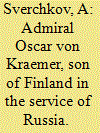

|
|
|
|
|
| Publication |
2014.
|
| Summary/Abstract |
MY ACQUAINTANCE with Oscar von Kraemer began in Denmark, at the museum of the town of Lemvig, in the section dedicated to the shipwreck of the Imperial Russian frigate Alexander Nevsky. I learned about the life of this all-around interesting man when I came across a book published by Finnish historians Bernhard Estlander and Karl Ekman in Helsinki in 1931, entitled "Fran hav och hov" (in the translation from Swedish - "At sea and court"). It is based on the rich
epistolary legacy of von Kraemer, who, in addition, possessed an extraordinary literary gift. This book not only gives an excellent portrayal of this undoubtedly talented man, but is an interesting evidence of an entire era in the history of Russia and its Navy. The name of Kraemer says little to the present generation of Russians and Finns. I do not think that his biography is well known to naval historians of these two countries either. The admiral's personal belongings and papers are kept in the National Archives of Finland and by his descendants living in this country.
|
|
|
|
|
|
|
|
|
|
|
|
|
|
|
|
| 3 |
ID:
129442
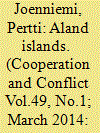

|
|
|
|
|
| Publication |
2014.
|
| Summary/Abstract |
The Åland Islands received their co-sovereign standing from the League of Nations in 1921, the settlement of a Finnish-Swedish dispute. The clash was over ownership, and the league advocated that Åland should remain part of Finland, albeit elevated to the status of a self-governing polity. The verdict implied that Finland's sovereignty was significantly compromised, whereas the islands landed in an in-between situation, being neither local nor fully sovereign. The duality of Åland - remaining an integral part of Finland yet still distinct with a standing of its own, including various cultural and linguistic safeguards - meant more generally that the islands fall through the interstices of the dominant discourses pertaining to political space. However, the lack of any clear conceptual standing has not amounted to anything profoundly disadvantageous. Their liminal nature of being neither this nor that has instead furnished the islands with a rather favourable posture. Their standing, although initially perceived as a loss and still seen in some interventions as unwarranted and viewed as a source of ontological uncertainty, arguably accounts for their ability to transform what usually appears as weakness into a considerable degree of influence. The article thus aims to explore what explains such an outcome and the manner in which the ambiguity of the islands has stood the test of time, taking into account that their standing has, among other things, been impacted by Finland and the islands both joining the EU in 1995 and the sovereignty games involved.
|
|
|
|
|
|
|
|
|
|
|
|
|
|
|
|
| 4 |
ID:
183044
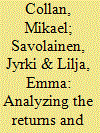

|
|
|
|
|
| Summary/Abstract |
Electricity distribution prices have steeply increased in Finland since 2015. This research investigates the returns from the Finnish low-voltage electricity distribution business and compares them to returns from three European industry indices. The within-industry distribution of returns is also studied. The Finnish rate of return regulation model used is presented together with the level of allowed returns by the model, four changes to the model are proposed, and the effect of the four proposed changes on the returns allowed by the model are investigated.
|
|
|
|
|
|
|
|
|
|
|
|
|
|
|
|
| 5 |
ID:
066229


|
|
|
| 6 |
ID:
112057
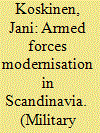

|
|
|
| 7 |
ID:
166656
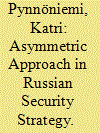

|
|
|
|
|
| Summary/Abstract |
Two observations stand out from the Russian strategic outlook. First, it corresponds with the real politik vision of world politics where the states engage in (zero-sum) competition for power and resources. Second, the new world order emerges because of a conflict between different models of development and value systems. These two observations highlight a certain “family resemblance” between the current Russian assessment of the current security environment and the situation during the Cold War. Furthermore, Russian national security strategy is oriented toward achieving strategic stability with the other great powers. The maintenance of strategic parity (nuclear and conventional deterrence) is a means to this end. However, given Russia’s relative weakness in comparison to its major geopolitical competitors, this has led to the renewal of the Cold War-era concept of asymmetric approach. Although this concept is most often used in the context of nuclear deterrence and the debate on “strategic stability,” it is not about military security only. The set of asymmetric measures from economic dependence or sanctions, to diplomatic, political, and informational measures are used to prevent an emergence of a conflict that would threaten Russia’s sovereignty and domestic stability. The purpose of this paper is to explore the Soviet roots of Active Measures and how the Soviet heritage is present at both the theoretical level and in concrete practices. Finally, insights from the conceptual analysis are applied in assessing the vulnerability of the Nordic countries, in particular Finland and Sweden, to Russian influence operations.
|
|
|
|
|
|
|
|
|
|
|
|
|
|
|
|
| 8 |
ID:
074715
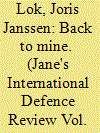

|
|
|
| 9 |
ID:
166363
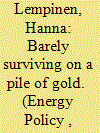

|
|
|
|
|
| Summary/Abstract |
While the share of peat in Finland's energy mix today amounts to only around 4%, peat recurrently returns to the center stage in Finnish energy-related public debates. As an indigenous energy resource, peat is a welcome addition to the energy mix of the heavily energy-dependent country. In addition, the employment impacts of peat production are considered significant. These benefits are, however, contradicted by the environmental impacts and climate emissions caused by peat energy. The conflicting interests revolving around peat have resulted in constantly shifting national peat policies as well as infrequent “explosions” of public and political debates on peat production. This article explores two of the most recent politicizations of peat through an empirical focus on the short-lived promotion campaigns that sparked widespread public debate: the 2010 “2 prosenttia” [2%] internet campaign from the state-majority-owned energy company VAPO and the 2017 “Turveinfo” [peat info] campaign launched by The Bioenergy Association of Finland. Through an analysis of the colorful and provocative promotion campaigns, this article (1) explores the arguments and rhetoric through which political support of peat is being acquired from the Finnish public and (2) examines what crises in the 2010s Finland peat is constructed as the (only) logical answer for.
|
|
|
|
|
|
|
|
|
|
|
|
|
|
|
|
| 10 |
ID:
098690
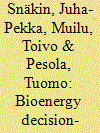

|
|
|
|
|
| Publication |
2010.
|
| Summary/Abstract |
Finnish farmers' role as energy producers is small compared to their role as energy resource owners. Since climate and energy policy in Finland continues favoring large-scale energy visions, additional investment support for agriculture will stay modest. To utilize fully the energy potential in farms, we analyze the farmers' decision-making environment. First, we present an overview of the Finnish energy policy and economy and their effect on farms (the top-down perspective). Then we analyze the drivers behind the bioenergy decisions of farms in general and in the Oulu region, located in Northern Finland (the bottom-up perspective). There is weak policy coherence between national and regional energy efforts. Strong pressure is placed on farmers to improve their business and marketing knowledge, innovation and financial abilities, education level, and networking skills. In the Oulu region, bioenergy forerunners can be divided in three different groups - investors, entrepreneurs and hobbyists - that have different levels of commitment to their energy businesses. This further stresses the importance of getting quality business services from numerous service providers.
|
|
|
|
|
|
|
|
|
|
|
|
|
|
|
|
| 11 |
ID:
052297


|
|
|
|
|
| Publication |
Oct 2004.
|
| Summary/Abstract |
The use of biomass in Finland and Sweden has steadily increased over the past 25 years, up to approximately 20% of the primary energy supply in 2001. In both countries most biomass originates from forests. Forest biomass is now an integral part of modern energy systems, although primarily in industry and in the heating sector. For example, biomass accounts for 7.9% and 53% of the fuel mix in district heating in Finland and Sweden, respectively.
The general energy policy of both countries has supported biomass for energy over the entire period, although specific policies have changed with time. Research, development and demonstration has been continuously supported, and some subsidy schemes have been applied, in particular, for district heating systems (DHS) and combined heat and power. Heavy taxation of competing fossil fuels seems to have been the most effective policy instrument, although this has been directed mainly at the heat and transportation fuel markets. Electricity taxes are imposed on consumption (industry is largely exempt), and do not discriminate significantly between the sources of electricity. Starting in 2003, Sweden will have a quota-based system, a renewable portfolio standard, which is expected to increase biomass-based electricity production.
Both countries possess vast and not fully exploited biomass resources in the form of forests, and have a history of rational and large-scale forestry. Strong actors exist both with regard to forest ownership and the industrial processing of forest products. The user side, in particular, represented by DHS, can also be characterised by strong and professional management. Over time, structures have developed that facilitate an increased use of biomass for energy, for example, the forest industry infrastructure and extensive district heating. Actors within these structures have had the ability to react to policies, resulting in a stable growth in biomass use.
|
|
|
|
|
|
|
|
|
|
|
|
|
|
|
|
| 12 |
ID:
034915


|
|
|
|
|
| Publication |
London, Her Majesty's Stationery Office, 1970.
|
| Description |
lx, 640p.Hbk
|
| Series |
History of Second World War
|
| Contents |
Vol. I.
|
| Standard Number |
116300523
|
|
|
|
|
|
|
|
|
|
|
|
Copies: C:1/I:0,R:0,Q:0
Circulation
| Accession# | Call# | Current Location | Status | Policy | Location |
| 007653 | 940.532452/WOO 007653 | Main | On Shelf | General | |
|
|
|
|
| 13 |
ID:
131724
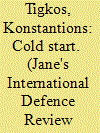

|
|
|
|
|
| Publication |
2014.
|
| Summary/Abstract |
The grounds of Kainuu Brigade in North Finland are home to one of the country's three readiness formations, along with Pori in the West and Karelia in the East. The north is also home to the North Finland Signals Battalion and is the epicentre of activities surrounding the Finnish Army's tactical command, control (C2), and communications systems.
|
|
|
|
|
|
|
|
|
|
|
|
|
|
|
|
| 14 |
ID:
185955
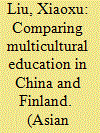

|
|
|
|
|
| Summary/Abstract |
Over the last several decades multicultural education has played a key role in many educational policies and practices internationally. In this article, the author examines multicultural education in the Chinese and Finnish contexts through a comparative study. The comparison includes the scope of diversity, the policy and practice of multicultural education, and what two distinct educational systems can learn from each other. A critical multicultural education framework and pluralistic unity nationality theory have been employed to discuss the policy and practice of multicultural education in both countries. The analysis clarifies commonalities and context-bound differences. Implications and suggestions for further development of multicultural education in both countries are also explored.
|
|
|
|
|
|
|
|
|
|
|
|
|
|
|
|
| 15 |
ID:
074551
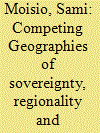

|
|
|
|
|
| Publication |
2006.
|
| Summary/Abstract |
European integration is often naturalised, so that the movement of a particular state towards integration, or away from it, is understood as being underpinned by eternal and everlasting national forces. The political struggles within the EU applicant states have not inspired scholars to produce sensitive studies of the "national debates" carried on in applicant states, even though this is exactly the field of political action where politico-geographical categories such as national identity, sovereignty and security come to be enthusiastically articulated. This paper both seeks to explain the struggle over Finland's decision to join the EU by focusing on the argumentation of those actors who "lost" the political struggle, and introduces the geographies that the opponents of Finnish EU membership produced. It is therefore aimed at illustrating the politics that underlay the geographical articulations which referred to either "national identity" or "sovereignty". The purpose of doing this is to trace the competing geographies involved in the Finnish EU struggle and to point out that they were indeed based on long historical traditions which competing political actors used as a source of legitimation in their political action. Most of the themes highlighted by the No-EU camp are prominent in contemporary EU debates, too.
|
|
|
|
|
|
|
|
|
|
|
|
|
|
|
|
| 16 |
ID:
108628
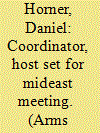

|
|
|
|
|
| Publication |
2011.
|
| Summary/Abstract |
The organizers of a planned 2012 conference on creating a zone free of weapons of mass destruction (WMD) in the Middle East have chosen a Finnish diplomat as the coordinator and Finland as the host country, UN Secretary-General Ban Ki-moon said in an Oct. 14 press statement.
|
|
|
|
|
|
|
|
|
|
|
|
|
|
|
|
| 17 |
ID:
073573
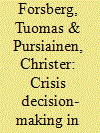

|
|
|
|
|
| Publication |
2006.
|
| Summary/Abstract |
This article reviews 17 Finnish crises since the Second World War from a perspective of three sets of questions derived from the theoretical literature. The questions deal with the construction of crisis, formation of the decision-making unit and rationality of decision-making. Although it is not possible to find a fully regular pattern of a particular type of crisis behaviour, some general observations can be made. In Finland, decision-making is often left in the hands of a small elite group, except in the case of civilian emergencies when key decisions are made at the operational level. The political elite, including the business community, have been fairly united and have rejected critical opinions during a crisis. Yet, contrary to some assumptions about the government using 'crisis' as a vehicle for acquiring more power, Finns generally avoid defining difficult situations as a 'crisis', instead reacting to them cautiously rather than in panic.
|
|
|
|
|
|
|
|
|
|
|
|
|
|
|
|
| 18 |
ID:
187346
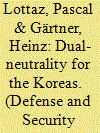

|
|
|
|
|
| Summary/Abstract |
This article builds a novel argument for the unification of the two Korean states by way of a dual neutralisation process. After reviewing the neutralisation concept and the history of neutrality ideas for the peninsula, the authors introduce two historical models that would fit the security needs of both Koreas and their respective security partners. Using a realist framework, it is argued that the “Finlandisation” of the DPRK on the one hand; and the “Austriasation” of the ROK on the other, would not change the de facto security relationships with their patrons, but would create the structural underpinning for future foreign policy compatibility. Assuming other factors remain equal and a solution to internal political division could be brokered, the article proposes a security framework for both states aimed at separately creating the structures for a future unified neutral Korea.
|
|
|
|
|
|
|
|
|
|
|
|
|
|
|
|
| 19 |
ID:
183084
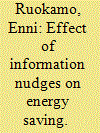

|
|
|
|
|
| Summary/Abstract |
Field experiments have shown that information nudging can help households to save energy, however, the effectiveness varies depending on aspects such as information content, delivery mode and study area. This article evaluates the impacts of information nudges on residential electricity consumption with a randomized field experiment. This opt-in experiment was conducted in Finland. Information was administered via monthly email newsletters and an online energy service platform. The aim is to find out whether i) energy saving tips combined with and without online energy service platform providing electricity consumption information, and ii) peer comparisons (i.e., social norm) influence households’ electricity consumption. The results show a high seasonal variation in the treatment effects within the groups who were registered users of the online energy service platform. Those with access to usage feedback and versatile energy savings tips (without the social norm comparisons) reduced their electricity consumption around 10% in wintertime. The results imply challenges in encouraging energy saving behavior among households less interested in following their electricity consumption.
|
|
|
|
|
|
|
|
|
|
|
|
|
|
|
|
| 20 |
ID:
127244


|
|
|
|
|
| Publication |
2014.
|
| Summary/Abstract |
There is an increasing political pressure on the city planning to create more energy efficient city plans. Not only do the city plans have to enable and promote energy efficient solutions, but it also needs to be clearly assessed how energy efficient the plans are. City planners often have no or poor know how about energy efficiency and building technologies which makes it difficult for them to answer to this need without new guidelines and tools. An easy to use tool for the assessment of the energy efficiency of detailed city plans was developed. The aim of the tool is for city planners to easily be able to assess the energy efficiency of the proposed detailed city plan and to be able to compare the impacts of changes in the plan. The tool is designed to be used with no in-depth knowledge about energy or building technology. With a wide use of the tool many missed opportunities for improving energy efficiency can be avoided. It will provide better opportunities for sustainable solutions leading to less harmful environmental impact and reduced emissions.
|
|
|
|
|
|
|
|
|
|
|
|
|
|
|
|
|
|
|
|
|